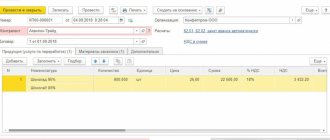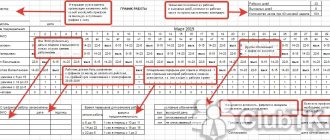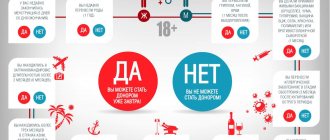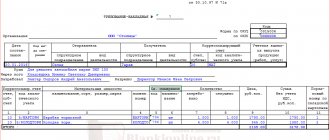Home Business Trade
The essence of bonuses is to motivate, encourage, attract attention in order to form permanent relationships, strong connections, trade and exchange processes. The concept is used mainly by Russians in the process of trade and exchange relations. In global trade terminology, the definition most often used is “discount” with the English discount. Essentially, a retro bonus is nothing more than a payment made taking into account the following options:
However, there is such a thing as a “retro bonus”. Bonus - in marketing, additional remuneration, encouragement, bonuses. The concept of bonus comes from the Latin word bonus - good.
The main purpose of the bonus is to promote and motivate ongoing relationships: purchase, processing. Retro" comes from "retrospective". Being retrospective means looking back at events that have already happened.
In trading, often you want to look back at the entire process to understand what you did right and wrong. Agile retrospectives are a great way to continually improve the way you work. Obtaining actions from the retrospective that can be done and taking them helps teams learn and improve. There's an overview of things you can use to benefit from your retrospectives.
The difference between a retro bonus and a premium
Despite the fact that a retro bonus is an independent lever of influence on sales promotion and is quite often practiced, the legislation does not consider it as a separate tool. The Tax Code of the Russian Federation identifies such a bonus as a premium that the seller pays to the buyer in monetary terms as an incentive for fulfilling certain points of the contract, for example, for purchasing a certain volume of goods.
In this case, the specified premium can also be essentially a discount and represent a reduction in the contractual cost of products, or a reduction in the amount of debt for supplies.
Explanation
Retro discounts (Retro bonuses) are provided for purchase volumes completed in the past period, that is, retrospectively. That's why they are called retro discounts or retro bonuses.
Example
The terms of the supply agreement provide that the buyer receives the right to a premium in the amount of 1% of the amount of purchased goods exceeding 10 million rubles for the previous year.
Retro discount can be provided in several ways:
1) reducing the buyer’s debt to pay for the goods by the amount of the retro discount;
2) payment to the buyer of a cash premium;
3) by crediting the retro discount against payment for the next batch of goods.
Taxation of retro discount
VAT
VAT for retro discounts is regulated by clause 2.1 of Art. 154 of the Tax Code of the Russian Federation, which was introduced by Federal Law dated 04/05/2013 N 39-FZ:
"2.1. Payment (provision) by the seller of goods (work, services) to their buyer of a premium (incentive payment) for the buyer’s fulfillment of certain conditions of the contract for the supply of goods (performance of work, provision of services), including the purchase of a certain volume of goods (work, services), does not reduce for calculation purposes tax base by the seller of goods (work, services) (and applicable tax deductions by their buyer) the cost of shipped goods (work performed, services rendered), except for cases when the cost of shipped goods (work performed, services rendered) is reduced by the amount paid (provided) bonus (incentive payment) is provided for in the specified agreement.”
Accordingly, the seller should not recalculate the VAT accrued upon the sale of goods by the amount of the retro discount. The buyer also does not adjust the deduction amount for goods already purchased.
Corporate income tax
The amount of the provided retro discount is taken into account by the seller in non-operating expenses (clause 19.1, clause 1, article 265, clause 3, clause 7, article 272 of the Tax Code of the Russian Federation). The Ministry of Finance also agrees with this - letters dated 08/26/2016 N 03-03-07/49936, dated 04/10/2015 N 03-07-11/20448, dated 12/19/2012 N 03-03-06/1/668.
For the buyer, the amount of retro discounts received is taken into account as non-operating income (Article 250 of the Tax Code of the Russian Federation).
The term “retro discount” is found in court decisions:
Ruling of the Supreme Court of the Russian Federation dated June 22, 2016 No. 308-KG15-19017 in case No. A32-9413/2014: “Thus, the supplier (company) provided the buyer with a reward in the form of a retro discount and gave him a reversal (adjustment) invoice indicating the reduced price delivered goods."
Resolution of the Presidium of the Supreme Arbitration Court of the Russian Federation dated 02/07/2012 N 11637/11 in case N A40-56521/10-35-297 - “The progressive incentive bonus is calculated as a percentage (from 1 to 2.3 percent) of the total cost of goods supplied during the year, exceeding 80,000,000 rubles. The said premium can be calculated and collected by the company from the supplier quarterly.”
Resolution of the Ninth Arbitration Court of Appeal dated February 17, 2011 N 09AP-31126/2010-AK, 09AP-31127/2010-AK in case N A40-56521/10-35-297 - “Dirol Cadbury” (seller) asked to reduce the tax base according to VAT, taking into account the retro discount ."
Conditions for providing retro bonuses
The conditions for paying a retrospective discount due to a distributor may vary, but are always clearly stated in advance, at the stage of agreeing on a supply agreement.
- The most common option is that the buyer receives a bonus based on the results of fulfilling the sales plan. This may be the sale of goods for an agreed amount or the purchase of an agreed volume of products. In any case, using this method of bonuses, the supplier can increase sales of certain goods that need additional stimulation of demand.
- Compliance with the terms of the contract. If there were no violations of the key terms of the contract during the entire period of its validity, the seller can count on incentives. This includes, among other things, the strict fulfillment of financial obligations under the contract.
- The work is being carried out quickly. Some suppliers use this method of incentives for the prompt work of the dealer - fast shipment, delivery of the order on time, all this can be a reason for reward.
It should also be taken into account that certain restrictions are imposed on the payment of a retro bonus for the category of food products: by decision of the Government of the Russian Federation of July 2020. It was approved that the amount of remuneration cannot exceed 5% of the price of purchased products, and in the case of the purchase of certain types of socially significant food products, it is completely prohibited.
There are no restrictions on the amount of remuneration for the purchase of non-food products at the federal level yet, so the bonus percentage can be any, provided that such a motivational policy for the supplier company is sufficiently justified.
What can they provide a retro bonus for?
The conditions for providing a rebate should always be specified when concluding an agreement, since they can vary greatly. The system of retrospective discounts for goods is a flexible system that allows you to find the optimal implementation option in each specific case. Most often, the conditions under which distributors or sellers can count on bonuses are based on fulfilling or exceeding the following obligations:
- the sales plan indicators have been achieved - if the agreed volume of goods is sold or the stipulated amount is received for it, this indicates activity in the market; using this method, it is more convenient to regulate the sales of specific types of goods or these processes in a certain market segment;
- impeccable monetary discipline - when all the terms of the transaction are met “without a hitch”, including payment and delivery deadlines, an additional bonus may be offered for this;
- good distribution indicators - for which suppliers or manufacturers can reward their counterparties when they promptly and in the required quantities supply goods to retail chains; Other criteria for the quality of suppliers’ work are also possible;
- new customers - expanding the distribution network is beneficial not only to the distributors themselves, but also to manufacturers, and additional bonuses can be provided for this.
Classification of retro bonuses
The retrospective bonus has several payment options; information about which of them is applicable to a particular situation is indicated in the text of the contract or the corresponding additional agreement, which must be signed by both parties.
Bonus product
The simplest and most common type of retro bonuses in trading is free delivery of products. However, this type of relationship between the seller and the buyer is fraught with the emergence of additional tax obligations, for VAT for the first and for gross income for the second.
To avoid possible difficulties, it is important:
- sign a legally binding contract for the provision of a retro discount;
- have documentary evidence of the completed purchase and sale transaction of the agreed volume of products;
In monetary terms
The price of the goods under the contract already includes a retro discount, which is payable upon reaching the established purchase volume. In this case, the contract must stipulate:
- specific deadlines within which the purchase must be completed in full;
- purchase amount or volume of products that must be purchased to receive an incentive;
- percentage of monetary compensation from the total cost of the goods under the contract;
- the period during which the retro bonus will be credited.
The contract is signed by both parties, which means that all mentioned conditions are agreed upon.
As an option
An option implies the right, but not the obligation, of the buyer to purchase a product at a bonus price for a certain time period.
The contract must specify the conditions for obtaining the option: the timing of the special price, as well as the form of remuneration.
How to correctly apply discounts in accounting in the form of retro bonuses
1 tbsp. 265 Tax Code of the Russian Federation, paragraphs. 19.1.
We quote the law. “Non-operating expenses <...> include reasonable costs for carrying out activities not directly related to production and (or) sales. Such expenses include, in particular:...19.1) expenses in the form of a premium (discount) paid (provided) by the seller to the buyer as a result of fulfilling certain terms of the contract, in particular the volume of purchases..." (Clause 1 of Article 265 of the Tax Code of the Russian Federation as amended by the Federal Law of 06.06.2005 N 58-FZ).
Based on this formulation of the new norm of the Code, a mandatory condition appears for the recognition of such expenses. This is the presence of an agreement with the buyer, which stipulates the amount of the discount and the procedure for its provision.
Discounts can be provided immediately at the time of purchase of goods or, for example, upon reaching a certain sales volume. The accountant’s actions to reflect them in accounting <**> depend on the type of discounts.
<**> For the seller’s discount accounting scheme, see p. 14.
How and in what form are retro bonuses accrued?
Moment of accrual
- At the entrance - the bonus is paid when purchasing goods from the manufacturer.
- In warehouse – reward is accrued when already purchased products are stored. It is usually explained by an attempt to insure the distributor against a reduction in the price of the product (occurs when working with highly technical products that are quickly losing relevance). The latter, in turn, receives a discount on the purchase of a new product range.
- At the exit, the premium is payable upon the sale of the goods to the buyer. Thus, the supplier encourages not so much purchasing to fill the warehouse, but rather promoting sales by the distributor to the consumer.
Delivery method
Most often, a retro bonus is issued as a credit note, especially when making payments to customers from other countries. In accounting, a credit note is repaid by offsetting the debt. But there are also payments in cash - this method is similar to regular payment for goods.
Bonus - as a percentage of sales volume
If the retro bonus is paid as a percentage of the volume of sales of goods, then such conditions for its accrual must be taken into account in the consignment agreement concluded between the manufacturer and the distributor (accountants really do not like such agreements). The contract must mention that the price of the product to the distributor includes a retro bonus, which is payable if the distributor reaches a certain volume of purchases. Such retro bonuses are accumulated in the sales volume accounting system for each distributor. It is necessary to provide in the contract a format for notification and approval by the parties of the moment the bonuses begin to be accrued. Such a notice is signed by both parties as a fact of agreement on the bonus amount and payment terms.
How to calculate a retro bonus
Retrospective remuneration is usually calculated using the following formula:
Retro bonus = Amount of incentive for purchasing a specified volume of goods + compensation for related services.
The following services may be eligible for reimbursement when calculating the retrospective discount:
- Logistics.
- Product collection and packaging services.
- Marketing and promotion services.
The VAT charged to the retailer, as well as the cost of excise duty if the product is excisable, is not taken into account.
Under what conditions is it provided?
- The terms of the contract are observed at a high quality level . If the terms of the contract have not been violated by either party throughout its duration, the seller or distributor can count on a reward.
- The work is being carried out promptly . If the goods are shipped quickly, the distribution network receives the necessary products on time, the supplier can reward the distributor.
- Fulfillment of the sales plan . This could be the sale of goods for a large amount or the sale of a large volume of goods. In any case, using such a bonus, the supplier can increase sales of less popular products from the assortment.
Example of calculating retro bonuses
Bonus calculation system using examples:
- On agreed terms, the buyer purchases crystal vases from the supplier with a total value of 10 million rubles. The manufacturer’s marketing policy approved a retro bonus in the amount of 10 percent of the contract value, thus, the maximum incentive amount is 1 million rubles. 200,000 rubles were spent on packaging services, another 300,000 were spent on logistics services. Costs for services rendered are reimbursed in full, plus another 500,000 bonus for the volume purchased.
- Enterprise A sells chocolates from manufacturer B. The price of the agreement to receive a retrospective discount is 1,000,000 rubles. The maximum bonus for food products is 5%, i.e. 50,000 rubles under this agreement. A spent 30,000 rubles on promotion services; these costs will be paid by the manufacturer, and the buyer is also entitled to 20,000 as a bonus for selling the agreed volume of products.
Next, let's look at the options for posting retro bonuses
Use wiring:
- D 41 (15, 20, 25, 26, 44, 91) K 60 (if the cost of the overpayment received is reflected);
- D 19 K 60 (if VAT on the capitalized bonus product is taken into account);
- D 76 K 68 (if the VAT previously accepted for deduction from the advance payment is restored);
- D 68 K 19 (if accepted for deduction of VAT on capitalized bonus goods).
Here we will also take as a basis the most popular situations that seller accountants have to deal with:
- D 62 (50) K 90-1 (if sales revenue is reflected taking into account the discount);
- D 90-3 K 68 (if VAT is charged on the actual sales amount - for OSNO);
- D 51 62 (when payment is received from the buyer taking into account the discount);
- D 62 K 90-1 (if revenue from the sale of a consignment of goods is reflected within the discount);
- D 90-2 K 62 (the amount of the discount provided to the buyer is included in the cost price (excluding VAT));
- D 90-2 K 41 (the cost of the bonus product is written off).
The seller takes into account retro bonuses using the following entries:
- D 62 K 62 (if the amount of the restored debt is recognized as an advance received against a future bonus delivery);
- D 76 K 68 (if VAT is charged on the amount of the prepayment, that is, the restored debt);
- D 68 K 76 (when VAT accrued on prepayment is accepted for deduction);
- D 62 K 90-1 (when revenue from the sale of bonus is reflected);
- D 90-3 K 68 (VAT is charged on proceeds from the sale of the bonus);
- D 90-2 K 41 (20) (when the cost of sold bonus goods is written off;
- D 68 K 76 (if VAT paid to the supplier as part of the advance is accepted for deduction)
What are additional retro bonuses and why are they needed?
Despite the fact that the retro bonus has documentary evidence in the form of a legally binding contract, which clearly states the cost of goods, in reality it happens that the price of products already shipped and received by the buyer may be subject to revision downward. So, for example, if a purchase contract was signed in one tax period, and the shipment was made in the next tax period, the supplier has the right to make a post-discount on the price of the goods.
The accounting department carries out this retro discount using a negative invoice. The use of such a document has been legal and legal from the point of view of the law since October 2011. Applying for this discount is not that difficult:
- The supplier issues a correction invoice.
- The seller notifies the buyer of the fact of a price reduction; this is done due to the need to document the recipient’s consent to the change in the price of the product.
- Having carried out the above actions, the supplier has the right to issue a retro discount as a special type of retro bonus.
The practice of reducing prices with retro bonuses
A retro bonus is a relationship in the form of a signed contract that specifies the price of the product; in practice, there are cases when the price of the product has already been sent and delivered to the recipient can be revised. This occurs when a transaction to supply goods was concluded during the tax period and the company makes a discount on the price of the goods that are sent after the tax period has expired. However, before using this type of retro bonus, you need to understand the intricacies of registering such a discount in the accounting department.
In accounting, such a retro discount is made on an irrefutable account. The mechanism for issuing a discount: first, the seller of goods draws up an adjustment invoice. Only if two of the above grounds exist, the seller has the right to issue a retro discount.
Overall, “intrade” is a simple and necessary thing, however, you need to get support and accounting knowledge before using it.
A retention bonus is a reward or reward outside of an employee's normal salary that is offered as an incentive to keep a key employee on the job during a particularly important business cycle, such as a merger or acquisition or during an important production period. Retention bonuses have become increasingly popular in recent years as corporate poaching has increased.
When an organization goes through a disruptive period of organizational change, it offers financial incentives to senior executives and key employees to persuade them to stay with the company until it becomes stable. The financial incentive is called a retention bonus. During a merger, restructuring or reorganization, a company will try to retain its best employees to make sure it has enough people working for the company during difficult times. For example, a business that is closing a department or project will offer bonuses to its top performers to ensure that it has employees in high demand.
In a rapidly growing economy in which employees offer and sell attractive benefits to other companies, the likelihood of a business losing its valuable employees to competitors is high. With the corporate landscape changing almost daily and the cash market making it easier for workers to move from job to job, retention bonuses have provided an excellent way for companies to retain key employees. In addition, employees who acquire new skills or receive training that are vital to the operation of the business can be offered retention bonuses to prevent them from taking their skills elsewhere.
A retention bonus is usually a one-time payment paid to an employee. Companies usually prefer to offer a retention bonus instead of a salary increase because they may not have the necessary finances to commit to a permanent salary increase. Depending on the company, the cost of retaining an employee's bonus may be tied to the length of time the employee has been with the firm. The bonus is paid at the end of the period as a percentage of the employee's current salary or a lump sum of money. For example, if the project is completely closed for 12 months, the employee retention bonus will be paid after 15 months to ensure that the employee remains for the remainder of the life of the project.
All bonuses, including retention bonuses, are considered as additional salary. Supplemental wages are simply defined as compensation paid in addition to an employee's regular wages. Taxes are generally applied to the withholding bonus using either the aggregate or percentage method. Under the percentage method, bonuses are separated from the employee's salary and are only taxed at a straight rate of 25%.
Legal registration
Payment of a retro bonus is a type of special contractual obligation that arises between two parties in the field of trade. To avoid misunderstandings and delays, as well as minimize the risk of problems with tax authorities, it is important to formalize these relationships correctly.
Retro bonus agreement
A retro discount is an additional measure of remuneration, therefore, in order to simplify the accounting of such transactions, it is more correct not to tie these auxiliary payments to the main purchase and sale agreement, but to formalize them as a separate agreement.
The retro bonus agreement is a key document in which the responsibilities of the parties are agreed upon and the amount of benefit received is fixed.
Important points when drawing up a contract:
- The agreement must be numbered and dated, and its name must contain a description of the purpose for its signing.
- Mention of the cost of the goods and methods of payment (cash or non-cash) are required.
- It is necessary to specify the percentage of the retro bonus offered to the buyer, in what period the reward will be paid, etc.
Additional agreement
This is a document that essentially repeats the contract itself. An agreement, unlike a contract, can be either written or oral.
Often, the agreement complements an already signed agreement, which specifies the amount of the bonus incentive and the main details regarding its receipt for a specific period of time, calendar month or other short-term billing period.
The additional agreement also specifies the form of payment, percentage and period for receiving bonus funds.
Accounting for remuneration in documents
When taking into account a retro bonus, you must strictly follow these steps:
- Calculate the amount of the reward - sometimes information about retro bonuses is finalized at the last moment.
- Retro bonuses are calculated separately for each order item, and it should be taken into account that:
- sometimes a retrospective discount is not calculated for all items in the order;
- Different types of products in the same order may require different incentive calculation approaches.
- Mandatory control of the full shipment of goods under a retro bonus agreement is required.
- In case of returning an item, make sure that items that carry a bonus are not returned.
Accounting for retro bonuses
There are two ways to reflect a retrospective discount in accounting:
- Attributing it to the cost of goods is the advantage of this method in ensuring transparent accounting of purchases and sales and possible flexible management of the selling price.
- Attribute it to the financial result - this option is practically more common:
- characteristic of the FMCG sector with its large number of operations;
- financial transactions under the transaction can take place even after the end of the reporting period, which makes it impossible to adjust the cost of production;
- The absence of specific regulations for accounting for remuneration forces the enterprise to maintain general accounting of bonuses. Accounting for financial results can be carried out not for the company as a whole, but selectively for product lines, for a specific brand or brand, etc.
The supplier may reduce the income portion in the reporting period when the incentive discount is provided to the distributor. Since total revenue has already been accounted for for the previous reporting period, the result of this adjustment will be an overpayment of income tax. The issue can be resolved in accordance with Article 54 of the Tax Code of the Russian Federation, which describes the possibility of accounting for a retrospective discount not as income of the previous reporting period, but in the expenditure part of the current one. This will help level out discrepancies between accounting and tax reporting.
To reflect the retro bonus in accounting, the debit of account 91 “Other income and expenses” and the credit of account 62 “Settlements with buyers and customers” are used.
With the receipt of a bonus reward, the buyer’s income increases, which leads to a revision of income tax. To do this, the buyer must submit a declaration with clarifications for the previous reporting period. It is also possible to take into account the incentive amount in the income portion of the current period in accordance with clause 1 of Art. 268 and paragraph 2 of Art. 272 of the Tax Code of the Russian Federation. However, the right to such accounting will have to be justified and proven in court (resolution of the Federal Arbitration Court of the North-Western District No. A05-3807/2012 dated 04/02/2013), therefore in most cases the first mentioned method is preferable.
Tax accounting of retro bonuses
Taxation of retro discounts depends on several nuances:
- Is VAT charged? The resulting discount is often subject to value added tax. If you initially increase the bonus amount by the standard rate of 18%, its size will be significant and unprofitable to return.
- For what group of goods is a reward offered - food or non-food (VAT is assessed differently). The price of food already includes VAT, so when taking into account the retro bonus, the full cost is used.
VAT
VAT for a retrospective discount is regulated by clause 2.1 of Art. 154 of the Tax Code of the Russian Federation, according to which payment of a premium for the purchase of a certain volume of goods does not reduce the cost of shipped goods for the calculation of the tax base by the seller, unless otherwise provided by the contract.
Accordingly, the supplier cannot recalculate the VAT calculated on the completed transaction for the amount of the retro bonus. The buyer also does not adjust the amount of tax deduction for goods already purchased.
Corporate income tax
The amount of the transferred remuneration is taken into account by the manufacturer as non-operating expenses (Article 272 of the Tax Code of the Russian Federation).
The buyer takes into account the bonus amount as non-operating income (Article 250 of the Tax Code of the Russian Federation).
A retro bonus is a simple sales promotion tool that is increasingly being used by counterparties in trade relations in our country.
But despite all its apparent simplicity, it is important to take a responsible approach to the legal registration of this bonus, as well as its subsequent accounting and tax accounting, so as not to incur sanctions for non-compliance with current laws.
How to reflect retro discounts and retro bonuses to the buyer?
Let's list some of the most common cases. Let's start with retro discounts:
If on the date of discounts the goods were not sold, the cost of the goods received is reduced by posting:
- D41 (15) K60
Regardless of whether the goods were sold or not, adjust the amount of input VAT:
- D 19 K 60
If the goods for which discounts were provided were sold in the current calendar year, make the following entries in accounting:
- D 90-2 K 41 (15)
Regardless of whether the goods were sold or not, adjust the amount of input VAT:
- D 19 K 60
If goods were sold in the previous year, their cost is not adjusted. The accounting reflects the profit of the previous reporting period identified in the current year:
- D 60 K 91-1
If a discount on work performed (services provided) is provided in the current year, then in accounting, reflect the decrease in their cost by posting:
- D 20 (25, 26, 44, 91) K 60
Retro bonuses: the VAT consequences for the buyer depend on the decision made by the seller
The amounts of bonuses received by the buyer for achieving the volume of purchases must be included in full in non-operating income
06/25/2013 GARANT Author: experts from the Legal Consulting Service GARANT Svetlana Ovchinnikova, Vyacheslav Gornostaev
Under a supply agreement, the organization purchases non-food products. According to the agreement, the supplier gives a retro bonus for a certain volume of purchases by setting it off as an advance payment from the buyer (against upcoming deliveries of goods) or to pay off the buyer’s receivables for goods already delivered. The supplier notifies the buyer of the amount of the retro bonus by sending him a credit note.
Is it legal for an organization (buyer) not to include the amounts of retro bonuses in the VAT tax base, taking them into account as part of non-operating income for income tax? What is the position of the authorities on this issue?
According to paragraph 1 of Art. 421 of the Civil Code of the Russian Federation, citizens and legal entities are free to enter into an agreement. In this case, the terms of the agreement are determined at the discretion of the parties, except in cases where the content of the relevant condition is prescribed by law or other legal acts (clause 4 of Article 421 of the Civil Code of the Russian Federation).
According to paragraph 1 of Art. 422 of the Civil Code of the Russian Federation, the contract must comply with the rules obligatory for the parties, established by law and other legal acts (imperative norms) in force at the time of its conclusion. Thus, organizations engaged in trading activities must take into account the provisions of the Federal Law of December 28, 2009 No. 381-FZ “On the fundamentals of state regulation of trading activities in the Russian Federation.”
Note that neither civil nor tax legislation defines the concept of “bonus”. In practice, the system of bonuses and premiums implies additional incentives from the supplier to the buyer, which are not directly related to a reduction in the price of the delivered goods.
Thus, in accordance with the norms of the Civil Code of the Russian Federation, the seller and the buyer have the right to stipulate in the purchase and sale (supply) agreement any conditions, including those upon fulfillment of which the buyer is provided (paid) with a bonus. A bonus provided for current or future deliveries, taking into account the conditions and volumes of purchases in the past, is considered a retro bonus.
By providing a discount to the buyer without changing the cost of the product in the form of a bonus, the seller has the right to pay the bonus amount in cash or reduce the buyer’s debt for previously delivered goods (or consider the provided bonus as an advance against new deliveries of goods), i.e. make a credit in accordance with Art. 410 of the Civil Code of the Russian Federation.
Typically, when providing a buyer with discounts, bonuses, or bonuses based on procurement results, the supplier sends the buyer a corresponding notice (credit note). A credit note is a settlement document that contains a notice sent by one of the parties in a settlement relationship to the other about the entry on credit of the account of the last specified amount due to the occurrence of some circumstance that created the right of the other party to claim this amount (see, for example, Resolution of the Tenth Arbitration Court of Appeal dated 01.08.2008 No. 10AP-2108/2008). Typically, a credit note contains information about a specific delivery and the amount of the discount provided.
Income tax
In accordance with paragraph 1 of Art. 248 of the Tax Code of the Russian Federation, income for the purposes of Chapter 25 of the Tax Code of the Russian Federation includes income from the sale of goods (work, services) and property rights and non-operating income.
Thus, income in the form of gratuitously received property (work, services) or property rights is recognized as non-operating income of the taxpayer, with the exception of the cases specified in Art. 251 of the Tax Code of the Russian Federation (clause 8 of Article 250 of the Tax Code of the Russian Federation).
According to paragraph 2 of Art. 248 of the Tax Code of the Russian Federation for tax purposes, property (work, services) or property rights are considered received free of charge if the receipt of this property (work, services) or property rights is not associated with the occurrence of an obligation on the recipient to transfer the property (property rights) to the transferor (perform for the transferor person of work, to provide services to the transferring person).
The Ministry of Finance of Russia in a letter dated September 15, 2005 No. 03-03-04/1/190 and the Federal Tax Service of Russia for Moscow in a letter dated March 21, 2007 No. 19-11/25335 indicated that if, due to the fulfillment of certain conditions of the contract, the seller will pay (provide) a premium (discount) to the buyer; for the buyer, such a discount will be a freely received property subject to inclusion in the tax base for corporate income tax.
In later letters, representatives of the Russian Ministry of Finance explained that, by their nature, premiums (discounts) received by the buyer as a result of fulfilling certain terms of the contract, in particular the volume of purchases, not related to changes in the price of a unit of goods, are taken into account for profit tax purposes as part of non-operating income, list which according to Art. 250 of the Tax Code of the Russian Federation is open (letters of the Ministry of Finance of Russia dated December 28, 2012 No. 03-01-18/10-200, dated December 19, 2012 No. 03-03-06/1/668, dated May 7, 2010 No. 03-03-06/1/316).
Thus, the amounts of bonuses received by the buyer for achieving the volume of purchases in tax accounting in any case should be included in full as part of non-operating income.
VAT
The object of VAT taxation is the sale of goods (work, services) on the territory of the Russian Federation (clause 1, clause 1, article 146 of the Tax Code of the Russian Federation).
In turn, on the basis of paragraph 1 of Art. 39 of the Tax Code of the Russian Federation, the sale of goods, work, and services is recognized, respectively, as the transfer on a paid basis (including the exchange of goods, work, and services) of ownership of goods, the results of work performed by one person for another person, the provision of services for a fee by one person to another person, and in cases provided for by the Tax Code of the Russian Federation, the transfer of ownership of goods, the results of work performed by one person for another person, the provision of services by one person to another person - on a free basis.
When determining the tax base, proceeds from the sale of goods (work, services), transfer of property rights are determined based on all income of the taxpayer associated with payments for the specified goods (work, services), property rights received by him in cash and (or) in kind (clause 2 of article 153 of the Tax Code of the Russian Federation).
According to paragraph 4 of Art. 166 of the Tax Code of the Russian Federation, the total amount of VAT payable to the budget is calculated based on the results of each tax period, taking into account changes that increase or decrease the tax base in the corresponding tax period.
Since when a bonus is provided to the buyer, there is no sale of goods (work, services), VAT is not required to be charged to the buyer.
Note that for a number of years, the position of the financial department and the tax service on the issue of applying VAT in relation to bonuses (remunerations) paid by the seller of goods to the buyer for achieving the volume of purchases of goods specified in the contract was expressed in the following approach.
According to representatives of the Ministry of Finance of Russia and the Federal Tax Service of Russia, two cases of incentives for the buyer should be distinguished:
– when premiums (bonuses and discounts) are not related to payment for services provided by the latter, and the payment of which does not lead to a change in the price of the product;
– when the terms of the supply agreement provide for the provision by the seller of goods of discounts (premiums, bonuses) to the buyer by changing the price of previously supplied goods.
In the first case, for the purpose of calculating VAT, the seller determines the tax base for goods sold without taking into account such premiums and rewards (bonuses). The indicated amounts should also not be recognized as payments related to settlements for the goods supplied, therefore there are no grounds for making changes to the invoices issued upon shipment of goods. Accordingly, the amounts of premiums and rewards (bonuses) received by the buyer of goods are not subject to VAT (letter of the Ministry of Finance of Russia dated December 13, 2010 No. 03-07-07/78, Federal Tax Service of Russia dated April 1, 2010 No. 3-0-06 /63, Federal Tax Service of Russia for Moscow dated 04/06/2010 No. 16-15/035737).
If the terms of the supply agreement provide for the seller of goods to provide discounts (bonuses and premiums) to the buyer by changing the price of previously supplied goods, the seller must reduce the VAT tax base by the amount of the discount provided and, accordingly, make changes to previously issued invoices, which serves as the basis to adjust the books of purchases and sales by all parties to the agreement (letters of the Ministry of Finance of Russia dated November 13, 2010 3 03-07-11/436, dated 04/29/2010 No. 03-07-11/158, dated 07/26/2007 No. 03-07-15/112, Federal Tax Service of Russia for Moscow dated 04/06/2010 No. 16-15/035737).
It should be noted that currently, when the cost of shipped goods (work performed, services rendered), transferred property rights changes, including in the event of a change in price (tariff) and (or) clarification of the quantity (volume) of shipped goods (work performed, services rendered), services), transferred property rights, the seller issues an adjustment invoice to the buyer in the manner prescribed by clause 3 of Art. 168 Tax Code of the Russian Federation.
A similar opinion was expressed by arbitration courts (see, for example, decisions of the FAS Moscow District dated September 10, 2010 No. KA-A40/10235-10-2, FAS East Siberian District dated September 2, 2010 No. A33-20390/2009, Federal Antimonopoly Service of the North-Western District dated 06/04/2010 No. F07-5440/2010 in case No. A26-8794/2009).
However, the Presidium of the Supreme Arbitration Court of the Russian Federation, in Resolution No. 11175/09 dated December 22, 2009, set out a different approach to the procedure for taxing bonuses and discounts. The supervisory authority came to the conclusion that regardless of how the parties to the distribution agreement determined the incentive system: by providing a discount that determines the size of a possible reduction in the base price of the product specified in the agreement, or by providing a bonus - an additional remuneration, a premium provided by the seller to the buyer for fulfilling the conditions transactions, as well as regardless of the procedure for providing discounts and bonuses (transfer to a current account, offset as an advance or debt reduction), when determining the tax base, the amount of revenue is subject to determination taking into account discounts, and, if necessary, adjustment for the tax period in which sales of goods (works, services) are reflected.
Later, the Presidium of the Supreme Arbitration Court, in resolution No. 11637/11 dated 02/07/2012, stated its position on this issue even more clearly, indicating that since bonuses are directly related to the supply of goods, it should be recognized that they are also a form of trade discounts applied to the cost of goods that affect the VAT tax base. As a result of the payment of bonuses by suppliers based on the results of shipment of goods, the cost of goods decreases, which entails an adjustment by suppliers of the VAT tax base, which means that the amount of VAT tax deductions previously declared by the buyer is also subject to a proportional reduction in the corresponding tax periods.
Thus, the judges of the Supreme Arbitration Court clearly formulated the rule: if, according to the terms of the supply agreement, the seller of goods provides for the provision of discounts (bonuses and premiums) to the buyer without changing the price of previously supplied goods, then the supplier has an obligation to adjust the tax base downward, and the buyer, accordingly, restore the previously declared deduction.
At the same time, it should be noted that, within the framework of its powers, the Presidium of the Supreme Arbitration Court of the Russian Federation considers, as a matter of supervision, cases of verification of judicial acts of arbitration courts of the Russian Federation that have entered into legal force, and also considers certain issues of judicial practice and informs arbitration courts in the Russian Federation about the results of consideration of these issues (Article 16 of the Federal Constitutional Law of April 28, 1995 No. 1-FKZ “On Arbitration Courts in the Russian Federation”). Unlike explanations on issues of judicial practice given by the Plenum of the Supreme Arbitration Court of the Russian Federation in the form of resolutions, resolutions and information letters of the Presidium of the Supreme Arbitration Court of the Russian Federation are not mandatory for application by arbitration courts. This circumstance must be taken into account when assessing the prospects for resolving the relevant dispute in arbitration courts.
At the same time, today there is arbitration practice in which judges adhere to the position of the Presidium of the Supreme Arbitration Court of the Russian Federation, contained in Resolution No. 11175/09 dated December 22, 2009 (Resolution of the Ninth Arbitration Court of Appeal dated March 12, 2013 No. 09AP-4785/13) .
The position of the Presidium of the Supreme Arbitration Court, set out in resolutions dated 02/07/2012 No. 11637/11 and dated 12/22/2009 No. 11175/09, was reflected in the explanations of the financial department (see, for example, letters of the Ministry of Finance of Russia dated 05/31/2012 No. 03-07-11/163, dated 05.17.2012 No. 03-07-14/52, dated 05.05.2010 No. 03-07-14/31, dated 04.09.2010 No. 03-07- 11/106), while the official position of the Russian Ministry of Finance on the issue of taxation of premiums (bonuses) without changing the original price of the goods in these letters remained the same.
In our opinion, based on the fact that the supplier’s provision of a bonus to the buyer does not change the cost of previously shipped goods, the purchasing organization does not need to adjust previously declared deductions. In this case, the bonus amount paid (accrued) by the supplier or buyer is not included in the VAT tax base.
At the same time, taking into account the different approaches to the issue under consideration between regulatory authorities and the supervisory authority, we believe that making a specific decision on this issue remains with your organization.
Moreover, we believe that the tax consequences of VAT for the buyer depend on the decision made by the seller.
If the seller decides not to reduce the prices of the goods supplied by the amount of the remuneration provided (bonuses and premiums), then such remuneration is included in the buyer’s income and does not give rise to any tax consequences for VAT.
If the seller decides to reduce the VAT tax base by the amount of the discount provided and, accordingly, makes changes to previously issued invoices, then the buyer will need to adjust the purchase book and restore the previously declared deduction.
Post:
Comments
How to register legally
The payment of retro bonuses is a type of relationship that arises between two parties. Each party has obligations. Therefore, it is important to formalize these relationships correctly.
Since bonuses are remuneration, it would be more correct, in order to simplify accounting, not to link these payments to the main sales contract. It is better to formalize this as a separate agreement.








